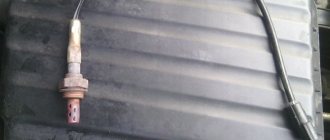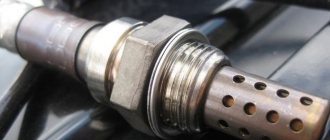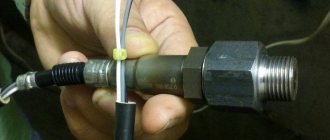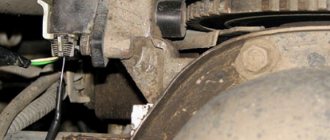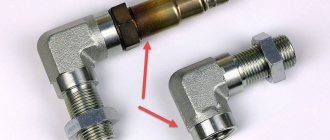Purpose
Knowledge of the operating features and purpose of a lambda probe is very useful for a car enthusiast.
Firstly, no one will be able to deceive the owner of the vehicle, and secondly, in the event of a breakdown, you can make a “diagnosis” yourself.
The task of the lambda probe is to create conditions for the catalytic converter to perform its functions, which filters the vehicle's exhaust.
Catalyst operation.
In essence, the catalyst reduces the harmfulness of the exhaust, and the lambda probe monitors the operation of this device.
The name of the probe comes from the well-known Greek letter “lambda”, which denotes the volume of oxygen in the prepared combustible mixture.
The lambda value is 14.7 units per unit of fuel. Proportionality is ensured thanks to electronic injection of the fuel mixture and the operation of a lambda probe.
The purpose of the device also depends on its position in the vehicle.
As a rule, an oxygen sensor is mounted in front of the catalyst, which makes it possible to accurately measure the oxygen level in the combustible mixture, and in case of imbalance, give a signal to the injection control unit.
To increase operating efficiency, new car models are equipped with not one, but two sensors, attached to one and the other side of the catalyst.
This design allows for more accurate analysis of the exhaust composition.
Evolution of development
Previously, oxygen sensors were resistive, which reduced the accuracy of measurements and the reliability of the devices themselves.
A modern lambda probe works as a threshold device. In this case, the signal received from the sensor allows you to accurately record the level of oxygen ratio in the exhaust and correct it.
The optimal ratio is 14.7:1 (actual to required air volume). If the parameter ? meets this standard, then the mixture is ideal.
If the indicator is exceeded, the mixture is lean. If ?, on the contrary, is less, then there is a lot of mixture in the exhaust and the volume of oxygen is not enough for combustion.
The lambda probe was first manufactured in 1960 by Robert Bosch GmbH. The project manager was Günther Baumann.
The device entered mass production only 16 years later (in 1976). The first manufacturers to start production were Saab and Volvo.
The principle of operation of lambda probes
Oxygen sensors are equipped with wiring, one end of which is connected to the vehicle’s on-board system, which allows you to “request” data from the LZ about the state of the fuel mixture once every 2 seconds. As the RPM increases, the update frequency increases.
In essence, the LZ also functions as a galvanic cell. After installation in the exhaust manifold, the sensor heats up to 400 degrees under the influence of exhaust gas flows coming from the engine. In this state, the zirconium tip is “activated” and begins to “breathe” with outside air on one side and exhaust gases on the other. As soon as one of the electrodes detects a change in the amount of oxygen, a corresponding signal is transmitted to the machine’s control system.
The obtained information about the volume of oxygen in the mixture is analyzed by the control system, which allows you to maintain an optimal (stoichiometric) ratio of air and fuel in the combustion chambers of the car.
Healthy! The stoichiometric ratio of oxygen to fuel should be about 14.7:1.
To provide more accurate data adjustment, a second sensor is used, which is located behind the catalyst. However, the number of lambda probes may be greater.
Main device types
Today there are several types of oxygen sensors. All of them may differ according to several criteria:
- by number of wires - from 1 to 6;
- on the organization of the sensory element (there are two types - plate and finger);
- for fasteners in the exhaust pipe - flanged or threaded;
- according to the measurement range of the lambda parameter - broadband (measurement is made in the range from 0.7 to 1.6) or narrowband, controlling the lambda level at a level above unity.
Each type of device has its own characteristics.
One contact devices.
Equipped with one signal wire. It is through it that the signal generated by the device is transmitted.
2-pin sensors
Equipped with two wires. One is a signal, and the second performs the function of grounding through the device body.
Using the grounding conductor, you can accurately determine the performance of the signal wire.
3-pin
There is a signal wire, one ground wire and a third wire going to the heating device.
The peculiarity of such sensors is the rapid achievement of the desired temperature, an increased service life of the device, as well as lower requirements for the exhaust system.
The heating element, which is mounted in the system, has a power of 12 or 18 W.
4-pin
They have four wires:
- signal conductor,
- wire feeding the heating device;
- the third wire is “ground”;
- fourth wire - can be used to solve any other problems (depending on the vehicle control system).
This may be the position of the contacts.
The design of modern oxygen sensors
The oxygen sensor has two electrodes - internal and external.
The first is made of zirconium, and the second is made of platinum coating, which makes it more sensitive to oxygen.
The lambda probe is mounted in such a way that it passes the entire volume of exhaust gases of the vehicle.
As gases pass through, the external electrode evaluates the oxygen level in the exhaust gases, which leads to a change in the potential between the electrodes.
The greater the volume of oxygen, the higher the voltage level. The operating temperature of the zirconium with which the electrode is coated is 300-1000 degrees Celsius.
That is why oxygen sensors are structurally complemented by heaters, which are necessary at the time of start-up.
There are two types of sensors - point-to-point and wideband. They are similar in appearance, but differ in design and principle of operation.
Thus, a 2-point sensor consists of two electrodes. Its task is to fix the coefficient of increased air volume in the fuel mixture.
As for the broadband device, this is a more modern design. Its main feature is the use of injection current.
In this case, the design of the broadband sensor consists of two ceramic devices - a pumping device and a 2-point one.
Types of lambda probes
In addition to zirconium, titanium and broadband oxygen sensors are also used.
- Titanium. This type of oxygen generator has a sensitive element made of titanium dioxide. The operating temperature of such a sensor starts from 700 °C. Titanium lambda probes do not require the presence of atmospheric air, since their operating principle is based on changing the output voltage, depending on the oxygen concentration in the exhaust.
- The wideband lambda probe is an improved model. It consists of a zicronium sensor and a pumping element. The first measures the oxygen concentration in the exhaust gases, recording the voltage caused by the potential difference. Next, the reading is compared with a reference value (450 mV), and, in case of deviation, a current is supplied, causing the pumping of oxygen ions from the exhaust. This happens until the voltage becomes equal to the specified one.
The lambda probe is a very important element of the engine management system, and its malfunction can lead to difficulties in driving the car and cause increased wear and tear on other engine parts. And since it cannot be repaired, it must be immediately replaced with a new one.
Operating principle
Oxygen contains negatively charged ions. They are assembled on platinum electrodes and when the desired sensor temperature is reached (about 400 degrees Celsius), a potential difference (voltage) is created.
If the mixture is too lean, then the volume of oxygen in the gases will be high, and vice versa, if the mixture is rich, then there will be little oxygen.
In the first case, the voltage is 0.2-0.3 Volts, and in the second - 0.7-0.9 Volts.
The motor control system maintains a voltage level of about 0.4-0.6 Volts, that is, the lambda level is 1.0.
During movement, the operating modes of the motor change, which helps to adjust the voltage parameter in both directions. In this case, a narrowband sensor can only capture those parameters that are above zero.
The lambda probe, which is installed after the catalyst, has the same principle of operation.
After treating the gases with a catalyst, the oxygen level remains unchanged. This, in turn, allows you to maintain an optimal potential difference within 0.4-0.6 Volts.
How does an oxygen sensor work?
Modern cars use various types of lambda probes. Let's look at the design and operating principle of the most popular of them - an oxygen sensor based on zirconium dioxide (ZrO2). The sensor consists of the following main elements:
- External electrode - in contact with exhaust gases.
- The internal electrode is in contact with the atmosphere.
- Heating element - used to heat the lambda probe and bring it to operating temperature faster (about 300 ° C).
- Solid electrolyte - located between two electrodes (zirconium oxide).
- Frame.
- Tip protector - has special holes (perforations) for the entry of exhaust gases.
The outer and inner electrodes are platinum coated. The operating principle of such a lambda probe is based on the occurrence of a potential difference between oxygen-sensitive platinum layers (electrodes). This occurs when the electrolyte is heated, when oxygen ions from the air and exhaust gases pass through it. The voltage on the sensor electrodes depends on the oxygen concentration in the exhaust gases. The higher it is, the lower the voltage. The oxygen sensor signal voltage range is from 100 to 900 mV. The signal has a sinusoidal shape, in which three ranges are distinguished: from 100 to 450 mV - lean mixture, from 450 to 900 mV - rich mixture, 450 mV corresponds to the stoichiometric composition of the air-fuel mixture.
Wideband lambda probe: main differences, operating principle
A broadband sensor for measuring oxygen levels is a lambda probe, which is installed in modern cars.
Its peculiarity is that it acts as a catalyst at the entrance to the device. The required parameters are measured using the input current.
The main difference between a broadband sensor is that it contains two working elements - a pumping element and a 2-point ceramic heater.
During the injection process, oxygen is passed through the corresponding element under the influence of current.
The operating principle of the broadband probe is based on maintaining the voltage within 450 mV.
How long does the lambda probe work?
The first versions of oxygen sensors, with two wires, worked in the region of 50 thousand km during normal operation. The new design of probes with three or four wires will work in the region of 80 thousand km. Lambda probes installed in modern cars can last about 150 thousand km before replacement.
A separate subtype of these sensors are broadband lambda probes, which cover at least 150 thousand km, having a number of advantages. They are equipped with a separate output scale, so the driver can see in real time what mixture is being supplied to the engine. This device operates across the entire rev range and processes information at a much higher speed. Such sensors are especially useful for car owners who like to tune their engines.
Video: Lambda! Oxygen sensor and increased fuel consumption
What does a probe malfunction lead to?
The first trouble that results from the failure of the probe is an increase in the “gluttony” of the car and a deterioration in the overall dynamics.
The main reason is a distortion of the sensor readings, which leads to a deviation in the oxygen-to-fuel ratio.
If one sensor fails, the car remains on the move (much depends on the vehicle itself).
There are models in which failure of the mechanism leads to large amounts of fuel being consumed. As a result, urgent repairs may be required.
If the lambda probe breaks down, it should only be replaced with a similar mechanism.
If you install a device of a different type, the vehicle’s on-board computer may simply not perceive the signals from the new sensor.
If two sensors break down at once, the car becomes completely immobilized.
Read more here - signs of lambda probe malfunctions.
Causes of failure
It is worth noting that the oxygen sensor has increased sensitivity to breakdowns.
The cause of failure may be:
- Low quality fuel. With bad gasoline, certain parts of lead remain on the lambda probe. The appearance of such sputtering impairs the sensitivity of the electrode to the fuel mixture. Some time passes and the sensor can be thrown away.
- Mechanical failure. The oxygen sensor itself may fail. In this case, the main damages include a housing defect, a violation of the device winding, and so on.
The problem is solved by installing a new sensor. As for repairs, they are useless in case of such breakdowns.
3. Excessive volumes of fuel supplied to the engine cylinders simply do not have time to burn and fly out into the exhaust system in the form of soot.
Over time, black deposits accumulate on the components of the vehicle’s exhaust system, including the oxygen sensor. As a result, the lambda probe begins to work incorrectly.
As a “treatment” you can use special cleaners and rags to remove dirt. If the sensor clogs regularly, then it is better to change it.
How to identify a breakdown?
A malfunctioning lambda probe can be recognized by the following symptoms:
- increasing the overall toxicity of exhaust vapors. Of course, it is impossible to determine this indicator by eye. Only a special device can help here. If the CO level has increased significantly, then we can confidently say that the oxygen sensor has failed;
- An increase in the car’s “gluttony” is a problem that can be seen almost immediately. The only thing is that an increase in flow rate does not necessarily indicate a sensor malfunction;
- The Check Engine light coming on is another signal that something is wrong with the system. As practice shows, the lighting of this light is associated with a breakdown of the lambda probe. To more accurately determine the error and identify the defect, you need to go to the service.
It is also important to know how to check the lambda probe for serviceability.
Oxygen sensor malfunction
A specific failure of the sensor is its “poisoning,” as a result of which the sensor does not respond or responds slowly to changes in oxygen concentration. The cause of “poisoning” may be the use of leaded gasoline or silicone sealants during engine repairs. In the first case, the sensor is covered with a green powdery coating, and in the second - white. The controller counters the DC failure by transitioning from a closed to an open control loop, in which the signal from the oxygen sensor is not used. It should be borne in mind that the controller can evaluate a working oxygen sensor as faulty if the signal level does not change for a long time (more than 5 seconds) for reasons not directly related to the sensor. For example: a small signal may be due to low fuel pressure, clogged fuel injectors, air leaks into the exhaust manifold, etc. A large signal may be caused by leaking injectors, increased fuel pressure due to a malfunction of the pressure regulator, and so on.
A sensor malfunction can manifest itself as follows: unstable operation or engine stops at idle; jerking and/or lack of engine power and throttle response; detonation; increased toxicity of gases; increased fuel consumption. You should try to drive the car smoothly, avoiding intense acceleration. If it becomes necessary to remove the oxygen sensor, you should not do this on a cold engine. The edges of the sensor can be torn off. Pre-warm the engine so that due to the thermal expansion of the metal, the threaded connection of the sensor with the exhaust pipe will loosen. In general, this is the most vulnerable sensor of a car with an injection system. Its service life is approximately 50,000 km, depending on operating conditions and engine serviceability. Poor condition of oil scraper rings, antifreeze getting into the cylinders and exhaust pipes, enriched fuel-air mixture, and malfunctions in the ignition system greatly reduce its service life. The use of leaded gasoline is strictly unacceptable - lead spoils the platinum electrodes of the oxygen sensor after several uncontrolled refills.
Is it possible to turn off the lambda probe?
Disabling the oxygen sensor takes a few minutes for a specialist. But the benefits of such work raise serious doubts.
From the moment the lambda probe is turned off, the ECU switches to average fuel supply parameters to the engine, which affects reliability and fuel consumption (usually for the worse).
In addition, if the oxygen sensor is disconnected, it may be necessary to reflash the car’s ECU itself, because an error will constantly appear.
Therefore, if the lambda probe fails, it is advisable to replace it.
Lambda probe decoy: what is it?
When replacing the catalyst with a flame arrester or dismantling the device, the signals from the two lambda probes will be identical. This, in turn, will inevitably lead to errors.
The problem is solved by installing a lambda probe blende.
It comes in two types:
1. Mechanical.
By design, it is a spacer made of bronze and having certain dimensions. Inside the unit there is a special crumb with catalytic spraying, which helps harmful substances burn out.
2. Electronic.
This decoy is a device based on a microprocessor that analyzes the entire process of exhaust gas passage and processes data from the first sensor.
The task is to ensure correct operation of the engine control system in conditions where the catalyst is broken or removed.
What is a lambda probe
If we talk about what the lambda probe is responsible for, then it is easiest to characterize it as a device that determines the level of oxygen contained in the exhaust gases.
The fact is that an insufficient volume of air in the fuel system (λ > 1 - lean mixture) usually leads to the fact that hydrocarbons and the resulting carbon monoxide will not be completely oxidized. If, on the contrary, there is too much oxygen in this mixture (λ < 1 – rich mixture), then nitrogen oxides will not decompose into oxygen and nitrogen. Therefore, the presence of LZ in any system is simply necessary.
If we consider what a lambda probe is in a car, based on its design, then the oxygen sensor consists of the following elements:
- A ceramic tip (usually made from zirconium dioxide), equipped with protective screens, as well as openings for the intake of exhaust gases and atmospheric air. It is these screens that are the working elements of the LZ.
- Thermally conductive heating elements that are located inside the ceramic tips.
- Electrical signal current collectors located in the middle part of the oxygen sensors.
All these components (except for the sensitive parts of the tips) are covered with a metal case with a thread, thanks to which the part is fixed to the body of the receiving pipe.



